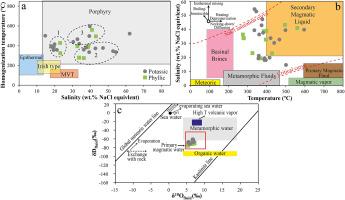Journal of Geochemical Exploration ( IF 3.9 ) Pub Date : 2020-12-24 , DOI: 10.1016/j.gexplo.2020.106719 Shahrouz Babazadeh , Jalil Ghalamghash , Massimo D’Antonio , Tanya Furman

|
We use the mineralogy, trace element compositions and elemental mass balance of volcanic materials collected from propylitic, potassic and phyllic alteration facies in the Eshtehard area of Iran to document the nature and effects of hydrothermal alteration. Incompatible element abundances in hydrothermally–altered samples show transformations that include: (i) depletion of alkalis and alkaline earth elements (i.e., Ba, Sr), (ii) variable behavior of first series transition elements (depletion in Cr, Co and Ni; enrichment in Zn and Cu), and (iii) depletion of HREE, Hf and Th relative to U and LREE. In detail, potassic (associated with a major addition of Cu) and phyllic zones are characterized by enrichment of SiO2 and MgO whereas propylitization depleted SiO2 and MnO, enriched MgO and Fe2O3, and increased LOI. Whole rock geochemistry along hydrothermal facies revealed consistent negative Ce and Eu anomalies, indicating that reducing conditions persisted during hydrothermal processes. Substantial changes in isovalent elements ratios (i.e., K/Ba, K/Rb, Y/Ho, Sr/Eu, Zr/Hf and Eu/Eu*) along the facies illustrate non–charge and radius control behavior are construed as lanthanide tetrad–effect phenomena. The co–occurrence of zigzag patterns (i.e., M and W–shapes) is evidence for partial or incomplete tetrad effect reaction between REE3+ and F-and Cl-rich fluids in hydrothermal systems. Low T4 tetrad–effect values overall suggest rock–fluid interaction involving rather low temperature hydrothermal solutions. Mass (ΔM) and volume (ΔV) were slightly depleted in the propylitic (−3.80% and −5.66%) potassic (−3.48% and −5.66%), and phyllic (−2.52% and −2.91%) zones with isocon slopes of 1.06, 1.06 and 1.03, respectively. We envisage a secondary phenomenon in open system conditions which accompanied fluid–rock interaction as the plausible cause of slight REE tetrad effect observed in the hydrothermally altered samples. Fluid inclusions studies yield homogenization temperatures of 275–596 °C and salinity ranging from 34 to 39 wt% NaCl equivalent suggesting boiling during mineralization in the Eshtehard area. The calculated δ18O and δD of the fluids range between 5.3 and 7.1 and −75 to −62 per mil, respectively. On this basis, we suggest that the ore-forming fluids had a magmatic source and underwent boiling and/or exchange with hydrous minerals.
中文翻译:

伊朗埃什哈特哈德火山的热液蚀变:微量元素再分布和稳定同位素地球化学的制约
我们使用从伊朗埃什特哈德地区的丙炔,钾和叶性蚀变相收集的火山岩材料的矿物学,微量元素组成和元素质量平衡来记录热液蚀变的性质和影响。水热改变的样品中不相容元素的丰度显示出以下变化:(i)碱和碱土元素(即Ba,Sr)的耗竭,(ii)第一系列过渡元素的可变行为(Cr,Co和Ni的耗竭; (iii)相对于U和LREE消耗HREE,Hf和Th。详细地讲,钾质(与大量添加的铜有关)和叶状区的特征是富含SiO 2和MgO,而丙基化却消耗了SiO 2。MnO,MgO和Fe 2 O 3富集,LOI增加。沿热液相的整个岩石地球化学显示一致的负Ce和Eu异常,表明在热液过程中还原条件持续存在。沿相的等价元素比率(即K / Ba,K / Rb,Y / Ho,Sr / Eu,Zr / Hf和Eu / Eu *)的显着变化说明非电荷和半径控制行为被解释为四价镧系元素效果现象。之字形图案(即M和W形)的同时出现是热液系统中REE 3+与富F和富Cl流体之间的部分或不完全四联效应反应的证据。低T 4四分体效应值总体表明,岩石-流体相互作用涉及低温热液溶液。质量(ΔM)和体积(ΔV)在带有等值线斜率的亚丙基(-3.88%和-5.66%)和叶状(-2.52%和-2.91%)的亚钾盐(-3.80%和-5.66%)和叶状(-2.52%和-2.91%)区域中被略微耗尽分别为1.06、1.06和1.03。我们设想在开放系统条件下伴随流体-岩石相互作用的第二种现象是在热液蚀变样品中观察到的轻微REE四重效应的可能原因。流体包裹体研究得出的均质温度为275–596°C,盐度范围为34-39 wt%NaCl当量,表明在埃什特哈德地区矿化期间沸腾。计算出的δ 18流体的O和δD分别在5.3和7.1和-75至-62 / mil之间。在此基础上,我们建议成矿流体具有岩浆来源,并经过沸腾和/或与含水矿物交换。



























 京公网安备 11010802027423号
京公网安备 11010802027423号